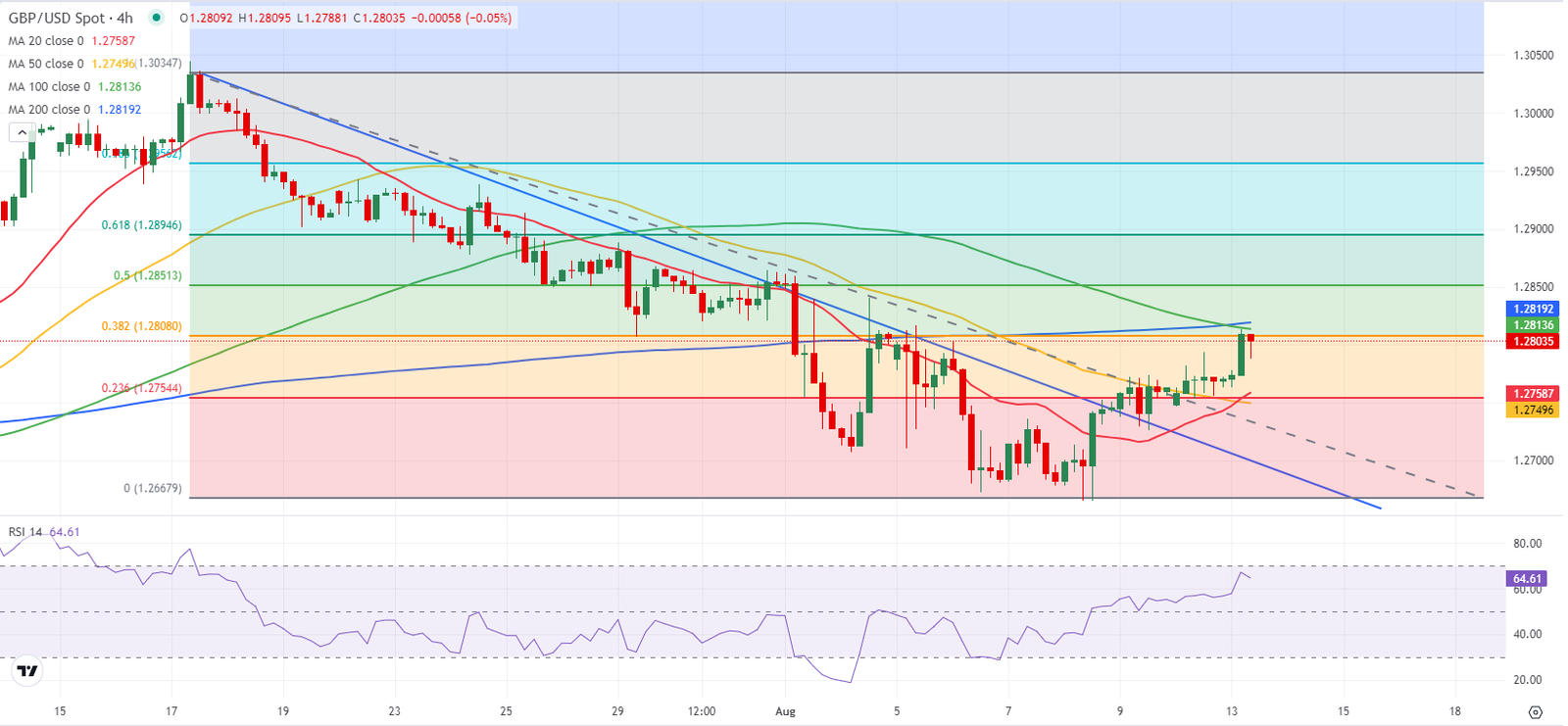- GBP/USD rose to a fresh weekly high above 1.2800 on Tuesday.
- Labor market data from the UK helped Pound Sterling find demand in the European morning.
- Technical buyers could take action if the pair clears the 1.2810-1.2820 resistance area.
GBP/USD gained traction in the early European session on Tuesday and climbed above 1.2800 for the first time in a week. The pair could stretch higher if it manages to clear the resistance area located at 1.2810-1.2820.
British Pound PRICE Today
The table below shows the percentage change of British Pound (GBP) against listed major currencies today. British Pound was the strongest against the Japanese Yen.
| USD | EUR | GBP | JPY | CAD | AUD | NZD | CHF | |
|---|---|---|---|---|---|---|---|---|
| USD | 0.07% | -0.28% | 0.37% | -0.08% | -0.22% | 0.13% | 0.21% | |
| EUR | -0.07% | -0.36% | 0.29% | -0.18% | -0.31% | -0.45% | 0.14% | |
| GBP | 0.28% | 0.36% | 0.64% | 0.19% | 0.05% | -0.07% | 0.52% | |
| JPY | -0.37% | -0.29% | -0.64% | -0.48% | -0.59% | -0.74% | -0.15% | |
| CAD | 0.08% | 0.18% | -0.19% | 0.48% | -0.14% | -0.29% | 0.31% | |
| AUD | 0.22% | 0.31% | -0.05% | 0.59% | 0.14% | -0.13% | 0.51% | |
| NZD | -0.13% | 0.45% | 0.07% | 0.74% | 0.29% | 0.13% | 0.60% | |
| CHF | -0.21% | -0.14% | -0.52% | 0.15% | -0.31% | -0.51% | -0.60% |
The heat map shows percentage changes of major currencies against each other. The base currency is picked from the left column, while the quote currency is picked from the top row. For example, if you pick the British Pound from the left column and move along the horizontal line to the US Dollar, the percentage change displayed in the box will represent GBP (base)/USD (quote).
The UK’s Office for national Statistics reported on Tuesday that the ILO Unemployment Rate declined to 4.2% in the three months to June from 4.4%. This reading came in below the market expectation of 4.5%. Additionally, the annual wage inflation, as measured by the change in the Average Earnings Excluding Bonus, edged lower to 5.4% in the same period from 5.7%, coming in above analysts’ estimate of 4.6%. With the immediate reaction, Pound Sterling gathered strength against its major rivals.
In the second half of the day, the US Bureau of Labor Statistics will release Producer Price Index (PPI) data for July. The immediate reaction to producer inflation data could be straightforward, with a stronger-than-forecast increase in the monthly PPI supporting the USD.
Nevertheless, investors could refrain from taking large positions ahead of the Consumer Price Index data from the UK and the US, which will be released on Wednesday.
GBP/USD Technical Analysis
The Relative Strength Index (RSI) indicator on the 4-hour chart stays above 60, highlighting a bullish bias in the near term. The Fibonacci 38.2% retracement level of the latest downtrend, the 100-period Simple Moving Average (SMA) and the 200-SMA form a stiff resistance area 1.2810-1.2820. In case GBP/USD rises above this area and starts using it as support, 1.2850 (Fibonacci 50% retracement) and 1.2900 (Fibonacci 61.8% retracement) could be seen as next resistance levels.
On the downside, supports are located at 1.2750 (Fibonacci 23.6% retracement, 50 period SMA), 1.2700 (psychological level, static level) and 1.2660 (end point of downtrend).
Pound Sterling FAQs
The Pound Sterling (GBP) is the oldest currency in the world (886 AD) and the official currency of the United Kingdom. It is the fourth most traded unit for foreign exchange (FX) in the world, accounting for 12% of all transactions, averaging $630 billion a day, according to 2022 data. Its key trading pairs are GBP/USD, aka ‘Cable’, which accounts for 11% of FX, GBP/JPY, or the ‘Dragon’ as it is known by traders (3%), and EUR/GBP (2%). The Pound Sterling is issued by the Bank of England (BoE).
The single most important factor influencing the value of the Pound Sterling is monetary policy decided by the Bank of England. The BoE bases its decisions on whether it has achieved its primary goal of “price stability” – a steady inflation rate of around 2%. Its primary tool for achieving this is the adjustment of interest rates. When inflation is too high, the BoE will try to rein it in by raising interest rates, making it more expensive for people and businesses to access credit. This is generally positive for GBP, as higher interest rates make the UK a more attractive place for global investors to park their money. When inflation falls too low it is a sign economic growth is slowing. In this scenario, the BoE will consider lowering interest rates to cheapen credit so businesses will borrow more to invest in growth-generating projects.
Data releases gauge the health of the economy and can impact the value of the Pound Sterling. Indicators such as GDP, Manufacturing and Services PMIs, and employment can all influence the direction of the GBP. A strong economy is good for Sterling. Not only does it attract more foreign investment but it may encourage the BoE to put up interest rates, which will directly strengthen GBP. Otherwise, if economic data is weak, the Pound Sterling is likely to fall.
Another significant data release for the Pound Sterling is the Trade Balance. This indicator measures the difference between what a country earns from its exports and what it spends on imports over a given period. If a country produces highly sought-after exports, its currency will benefit purely from the extra demand created from foreign buyers seeking to purchase these goods. Therefore, a positive net Trade Balance strengthens a currency and vice versa for a negative balance.








